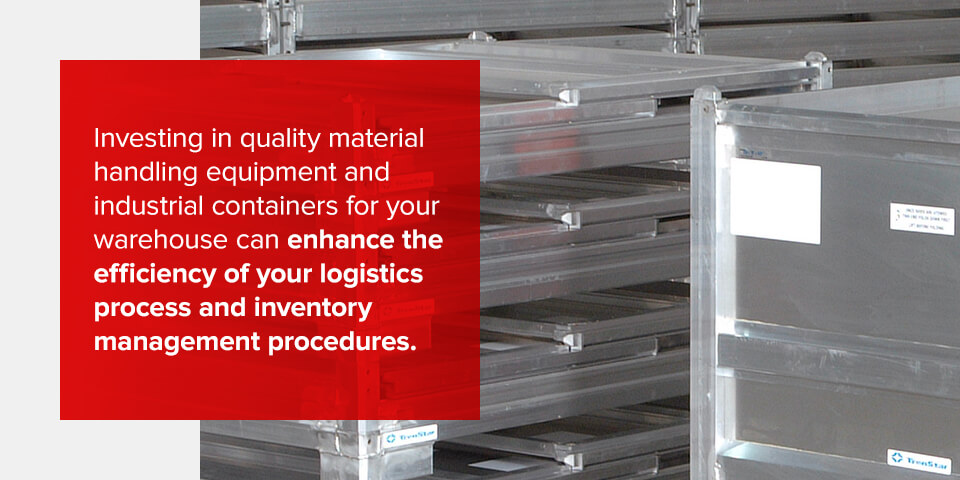
Retail stores in various industries and of all sizes have one major component in common — their inventory. Whether you sell food, clothes, machine parts, chemicals, or other products, your inventory is what keeps customers interested in your company. To stay successful and keep your warehouse procedures running smoothly, it’s important to keep accurate track of your inventory and carefully plan your product stock every year or quarter.
Jump to Sections:
- What Is Inventory Measurement?
- Challenges of Inventory Management Systems
- 10 Tips for Successful Inventory Management
- Inventory Management Methods
- Equipment Solutions From Cherry’s Material Handling
- Shop Online at Cherry’s Material Handling
When you know the inventory you have in stock and ready to ship out, it can help you make better reordering decisions for restocking and accurately communicate what products are available for purchase. Managing your inventory also allows you to record buying trends and patterns to better organize your warehouse and order the correct amount of products.

What Is Inventory Management?
As a retailer, it’s crucial to implement useful inventory management processes for your warehouse. Inventory management’s definition is the process in the supply chain that documents the inventory of products on your shelves and when they leave the facility. There are various methods for how to do inventory management successfully. For inventory management techniques and tips, this guide will provide helpful advice on different inventory management strategies to help improve your warehouse operations.
Challenges of Inventory Management Systems
Managing your inventory can help you become more profitable, but it is also a big task for retailers. First, assess whether you’re experiencing any common supply chain challenges, including:
- Inconsistent tracking: Companies that keep records of their inventory manually across various spreadsheets or documents may be prone to errors or duplicated data. Retailers may notice inaccuracies in their stock, online inventory or restocking with inconsistent tracking.
- Warehouse inefficiency: Poor inventory control methods may lead to a decrease in your warehouse efficiency. Many elements make up the movement of warehouse operations, like receiving, packing, transporting and shipping.
- Incorrect data: Companies that don’t keep tabs on their inventory records may encounter incorrect data for their current stock.
- Shifting demands: Accurate inventory control techniques can help point out changing customer demands. Without inventory management, companies may not notice purchasing trends for certain products and have too much or too little in stock.
- Manual records: Keeping a paper record of your inventory can become time-consuming and is unnecessary with the resources many companies have with technology.
- Narrow visibility: If your products are hard to locate in the warehouse because of poor inventory control, it can affect the picking and shipping process.
- Fragile or perishable products: Improper inventory control can lead to employees missing the need for a special storage and transport process of fragile or perishable products. Inventory management can help prevent product loss or damage.
- Supply chain changes: The ever-changing global supply chain can greatly impact your inventory and production if you don’t account for these modifications and include flexibility in your processes.
- Unoptimized warehouse space: An important task that helps organize your inventory is managing and optimizing your warehouse space. Warehouses may encounter challenges with inventory control if they don’t utilize their warehouse space to its maximum ability.
- Inaccurate order management: Retailers may experience inaccurate order management when they don’t take seasonal purchasing trends into account and oversell or undersell items.
- Outdated packaging: Different products require specific packaging to store and transport them safely and efficiently. Using inadequate packaging can lead to a shorter shelf life.
- Overstock: Not keeping track of your inventory properly can lead to items being overstocked. This can decrease your storage space and increase other inventory issues.
- Damage or loss of inventory: Inventory management strategies can help identify areas where items can become damaged or spoil. This inventory problem can happen if retailers don’t audit their inventory process.
- Lack of communication: Sharing inventory information and records with other departments is beneficial for inventory management. Not having clear communication can lead to unclear data and avoidable problems.
- Unproductive process: Manual inventory documentation along with a high sales volume, inefficient logistics process and lack of technology may result in an unproductive warehouse process.
- Weak production planning: Production planning helps a warehouse be productive in completing orders in a timely manner for shipment. A weak production plan can impact inventory management and may lead to downtime in production.
- Inadequate expertise: Companies can include the latest technology for their inventory control system, but an inventory manager who doesn’t know how to use the new software can affect inventory records.
- Increasing product selection: Retailers with limited items may get by without a strong inventory management strategy, but once they start to add more products, they may notice a need for inventory software.
- Rising competition: Working alongside rising competitors can cause retailers to face challenges with their inventory stock and receiving materials from suppliers.
- Lack of technology and software: Retailers without inventory management software are missing the opportunity to effectively track their products.
If your company is facing any of these challenges or wants to prevent them from affecting your supply chain, it’s important to learn how to keep track of inventory. Now is the perfect time to take the necessary steps to control your inventory.

10 Tips for Successful Inventory Management
The inventory management process requires planning and the right tools to accurately document items in your inventory and restocks. Investing in inventory control is a smart way to save your company time and money. Start creating an inventory management plan with these 10 tips to improve your inventory control:
1. Keep Records of All Product Information
Document all information about each of the products you have in your inventory. List the item numbers, bar codes, materials, supplier and any helpful information to distinguish the product. This inventory management tip can help with order picking and restocking to categorize the items.
2. Invest in Technology
Incorporating technology in the warehouse or store, like point of sale (POS) systems and scanners, can help organize product data fast and easily. Technology that helps with the inventory process can increase productivity and eliminate downtime.
3. Standardize the Restock Process
When you have incoming products for your inventory, it’s helpful to have a standard process for receiving. Making sure the process is cohesive, allows for inventory numbers to be accurate, and ensures inventory is unpackaged properly and placed in the storage system correctly. It also may be beneficial if your company handles ordering restock items instead of a third-party vendor.
4. Consider the 80/20 Rule
A general rule for most companies is that 80% of profits are from 20% of products. This indicates you can focus more of your inventory management resources on the 20% of products that profit you the most. Look at the sales data of these products and learn how many units you sell in a week or month.
5. Prioritize Inventory
Separate inventory into categories by popularity or how often customers purchase the items. This process can help with restocking and placement in the warehouse or store.
6. Audit Inventory
Technology is beneficial for inventory management, but it still may be necessary to physically count your inventory at some points. Whether you complete this task once a year, quarterly, monthly or daily, you can use the inventory audit to see if your digital data matches your physical inventory.
7. Record Supplier Conduct
Recognizing when one of your suppliers has unreliable behavior, like delivering materials late or communicating poorly, can help you decide when to take action and discuss this with the supplier. Determine and track the problem, and if there isn’t a solution, it might be time to switch suppliers.
8. Track Sales
Tracking your sales goes more in-depth than how much profit your company made. Consider keeping a record of product trends. What time of the year do certain products sell more? What products aren’t selling fast enough? Tracking your sales can help you keep your inventory organized and predict more accurate restock numbers.
9. Use Inventory Management Software
Whether you’re a big or small business, your facility can benefit from inventory tracking software to make the inventory management process smoother. It’s even better if the software and POS systems you have are compatible.
10. Have Quality Product Storage Systems
Having damaged or spoiled products can affect your inventory control and cost you if the issues aren’t noticed. Updating your packaging and storage methods is a great way to minimize product damage in your facility. Methods like plastic containers or industrial boxes and bins for various industries can help keep products secure.
Inventory Management Methods
Businesses of any size or industry can use inventory management techniques. These methods provide procedures for shipping, tracking and selling. Learn more about the different types of inventory management methods that can improve your tracking process:
- ABC method: This management process categorizes products into three different sections. Categories A, B and C separate products by how many units a product sells and its impact on profit. Category A contains the most popular products and contributes the most to your profit. Category B contains products that fall in the middle. Category C contains items that are part of smaller transactions.
- Just-in-time method: The just-in-time method (JIT) is a process that helps cut down on storage and inventory costs by ordering products only when needed for an order. JIT can decrease the amount of overstock that sits on warehouse shelves.
- Batch tracking: The process of batch tracking includes grouping products by their similar traits to perform quality control management. You can trace back items to a certain batch in the scenario they are damaged or will soon expire.
- Consignment inventory: Companies can choose to consign their inventory to a retail store in hopes of selling their products. This means the supplier gives their products to the consigner to sell without having to pay for the products upfront. The consigner pays for the products only when they sell.
- Backordering: Companies can still receive orders for products that are out of stock and wait to ship products until they receive them. This backordering method is helpful for some businesses, but not the best option for others. If you have a great inventory process and have strong restocking procedures, backordering can help boost sales.
- Dropshipping: To save on storage costs, a company can opt for dropshipping products to customers. The dropshipping method works by the seller not having their products in their inventory. Instead, they purchase orders from a third-party vendor.
- Cycle counting: If manually counting your inventory regularly isn’t an option, you can practice cycle counting for inventory management. Cycle counting involves counting a sample of your inventory to check that your data is accurate. This process is time-efficient and helps prevent downtime in your facility.

Equipment Solutions From Cherry’s Material Handling
Learning how to manage inventory effectively is an essential part of your business, and having the right equipment and tools for a smooth operations process adds to productivity. Investing in quality material handling equipment and industrial containers for your warehouse can enhance the efficiency of your logistics process and inventory management procedures.
At Cherry’s Material Handling, you can find a wide selection of equipment solutions for your operation, including:
- Industrial pallets
- Metal containers
- Pallet jacks
- Hand trucks
- Industrial lift tables
- Pallet racking
- Roller skids
Before employees operate material handling equipment like electric or gas pallet trucks, it’s crucial they are trained according to the Occupational Safety and Health Administration (OSHA) and certified to ensure optimal warehouse safety.

Shop Online at Cherry’s Material Handling
Enhancing your inventory management techniques is a fantastic way to improve your company’s success. To improve features of your warehouse used to store and pick products, purchase high-quality industrial equipment from Cherry’s Material Handling. We offer attentive customer service, reliable equipment and solutions for companies of all sizes. We have a wide selection of material handling equipment on our website and make it easy for you to shop for any of the supplies your company needs.
Having trouble finding equipment for a specific application? We may be able to provide the solution your company is looking for with our custom material handling equipment. You’ll find efficiency and reliability in the equipment we offer. Shop online today, contact us through our form or call 877-350-2729 to learn more about the equipment we offer.